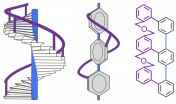(Press-News.org) The "surfactant" chemicals found in samples of fracking fluid collected in five states were no more toxic than substances commonly found in homes, according to a first-of-its-kind analysis by researchers at the University of Colorado Boulder.
Fracking fluid is largely comprised of water and sand, but oil and gas companies also add a variety of other chemicals, including anti-bacterial agents, corrosion inhibitors and surfactants. Surfactants reduce the surface tension between water and oil, allowing for more oil to be extracted from porous rock underground.
In a new study published in the journal Analytical Chemistry, the research team identified the surfactants found in fracking fluid samples from Colorado, Louisiana, Nevada, Pennsylvania and Texas. The results showed that the chemicals found in the fluid samples were also commonly found in everyday products, from toothpaste to laxatives to detergent to ice cream.
"This is the first published paper that identifies some of the organic fracking chemicals going down the well that companies use," said Michael Thurman, lead author of the paper and a co-founder of the Laboratory for Environmental Mass Spectrometry in CU-Boulder's College of Engineering and Applied Science. "We found chemicals in the samples we were running that most of us are putting down our drains at home."
Imma Ferrer, chief scientist at the mass spectrometry laboratory and co-author of the paper said, "Our unique instrumentation with accurate mass and intimate knowledge of ion chemistry was used to identify these chemicals." The mass spectrometry laboratory is sponsored by Agilent Technologies, Inc., which provides state-of-the art instrumentation and support.
The fluid samples analyzed for the study were provided through partnerships with Colorado State University and colleagues at CU-Boulder.
Hydraulic fracturing, or "fracking," is a technique used to increase the amount of oil and gas that can be extracted from the ground by forcing fluid down the well. Fracking has allowed for an explosion of oil and gas operations across the country. In the U.S. the number of natural gas wells has increased by 200,000 in the last two decades, according to the U.S. Energy Information Administration.
Among the concerns raised by the fracking boom is that the chemicals used in the fracking fluid might contaminate ground and surface water supplies. But determining the risk of contamination--or proving that any contamination has occurred in the past--has been difficult because oil and gas companies have been reluctant to share exactly what's in their proprietary fluid mixtures, citing stiff competition within the industry.
Recent state and federal regulations require companies to disclose what is being used in their fracking fluids, but the resulting lists typically use broad chemical categories to describe the actual ingredients.
The results of the new study are important not only because they give a picture of the possible toxicity of the fluid but because a detailed list of the ingredients can be used as a "fingerprint" to trace whether suspected contamination of water supplies actually originated from a fracking operation.
The authors caution that their results may not be applicable to all wells. Individual well operators use unique fracking fluid mixtures that may be modified depending on the underlying geology. Ferrer and Thurman are now working to analyze more water samples collected from other wells as part of a larger study at CU-Boulder exploring the impacts of natural gas development.
Thurman notes that there are other concerns about fracking--including air pollution, the antimicrobial biocides used in fracking fluids, wastewater disposal triggering earthquakes and the large amount of water used--that are important to investigate and ameliorate. But water pollution from surfactants in fracking fluid may not be as big a concern as previously thought.
"What we have learned in this piece of work is that the really toxic surfactants aren't being used in the wells we have tested," he said.
INFORMATION:
Other co-authors of the published study are Jens Blotevogel and Thomas Borch of Colorado State University. The study was funded in part by The Borch-Hoppess Fund for Environmental Contaminant Research.
Action movies may drive box office revenues, but dramas and deeper, more serious movies earn audience acclaim and appreciation, according to a team of researchers.
"Most people think that entertainment is just a silly diversion, but our research shows that entertainment is profoundly meaningful and moving for many people," said Mary Beth Oliver, Distinguished Professor in Media Studies and co-director of Media Effects Research Laboratory, Penn State. "It's not just types of entertainment that we usually think of as meaningful, such as poetry and dance, either, but also ...
Shark populations in the Mediterranean are highly divided, an international team of scientists, led by Dr Andrew Griffiths of the University of Bristol, has shown. Many previous studies on sharks suggest they move over large distances. But catsharks in the Mediterranean Sea appear to move and migrate much less, as revealed by this study. This could have important implications for conserving and managing sharks more widely, suggesting they may be more vulnerable to over-fishing than previously thought.
The study, published in the new journal Royal Society Open Science, ...
Providing health information on the internet may not be the "cure all" that it is hoped to be. It could sideline especially those Americans older than 65 years old who are not well versed in understanding health matters, and who do not use the web regularly. So says Helen Levy of the University of Michigan in the US, who led the first-ever study to show that elderly people's knowledge of health matters, so-called health literacy, also predicts how and if they use the internet. The findings¹ appear in the Journal of General Internal Medicine², published by Springer.
Substantial ...
Learning a new language changes your brain network both structurally and functionally, according to Penn State researchers.
"Learning and practicing something, for instance a second language, strengthens the brain," said Ping Li, professor of psychology, linguistics and information sciences and technology. "Like physical exercise, the more you use specific areas of your brain, the more it grows and gets stronger."
Li and colleagues studied 39 native English speakers' brains over a six-week period as half of the participants learned Chinese vocabulary. Of the subjects ...
The tree has been an effective model of evolution for 150 years, but a Rice University computer scientist believes it's far too simple to illustrate the breadth of current knowledge.
Rice researcher Luay Nakhleh and his group have developed PhyloNet, an open-source software package that accounts for horizontal as well as vertical inheritance of genetic material among genomes. His "maximum likelihood" method, detailed this month in the Proceedings of the National Academy of Sciences, allows PhyloNet to infer network models that better describe the evolution of certain ...
Most community-based mental health providers are not well prepared to take care of the special needs of military veterans and their families, according to a new study by the RAND Corporation that was commissioned by United Health Foundation in collaboration with the Military Officers Association of America.
The exploratory report, based on a survey of mental health providers nationally, found few community-based providers met criteria for military cultural competency or used evidence-based approaches to treat problems commonly seen among veterans.
"Our findings suggest ...
A new study from The University of Texas at Arlington biologists examining non-genetic changes in water flea development suggests something human parents have known for years - ensuring a future generations' success often means sacrifice.
Matthew Walsh, an assistant professor of biology, and his team looked at a phenomenon called "phenotypic plasticity" in the Daphnia abigua, or water flea. Phenotypic plasticity is when an organism changes its trait expressions or physical characteristics, or those of its offspring, because of external factors. In Daphnia, that can mean ...
Chemists at the University of Basel in Switzerland have succeeded in twisting a molecule by combining molecular strands of differing lengths. The longer strand winds around a central axis like a staircase banister, creating a helical structure that exhibits special physical properties. The results were published in the renowned scientific journal Angewandte Chemie International Edition.
The chemistry of all substances is to a large extent defined by their spatial arrangement. Many molecules can be present in two forms (enantiomers), which behave like a person's right ...
November 12, 2014 - In preschool-aged children, a simple test performed in the ophthalmologist's or optometrist's office greatly overestimates the eye's ability to "flex and focus" in order to see small objects clearly, reports a study in the November issue of END ...
Nanomedicine is offering patients a growing arsenal of therapeutic drugs for a variety of diseases but often at a cost of thousands of dollars a month. Generics could substantially reduce the price tag for patients -- if only there were a well-defined way to make and regulate them. An article in Chemical & Engineering News (C&EN), the weekly newsmagazine of the American Chemical Society, details the challenges on the road to generic nanodrugs.
Matt Davenport, a C&EN contributing editor, points out that in small-molecule therapeutics -- aspirin, for example -- the active ...



